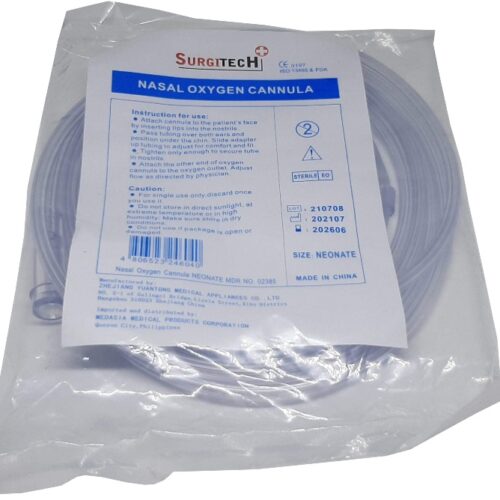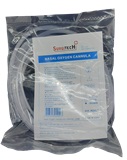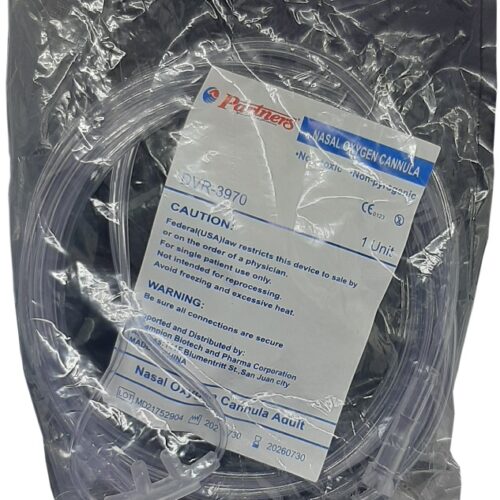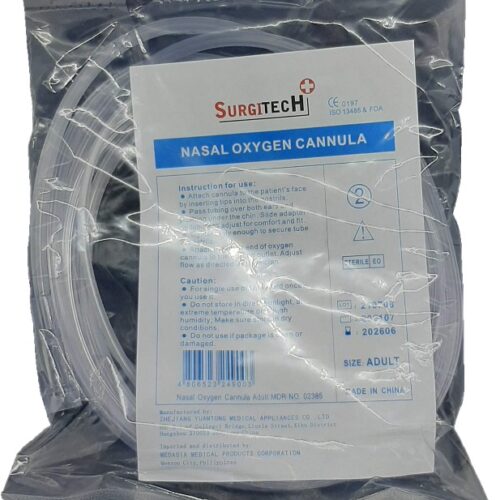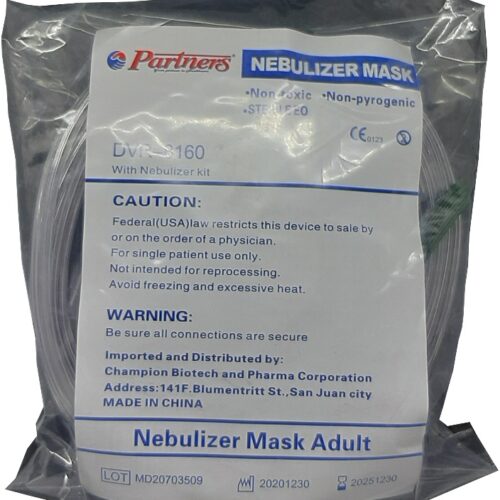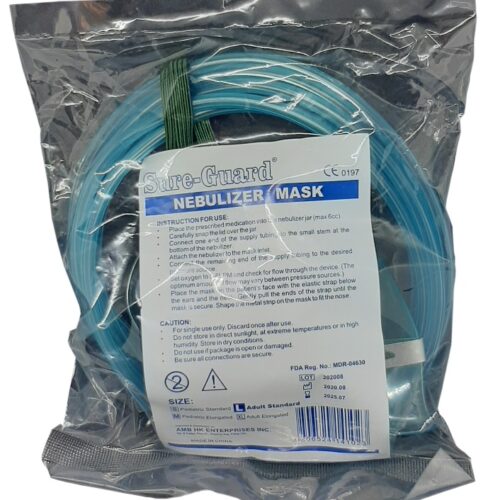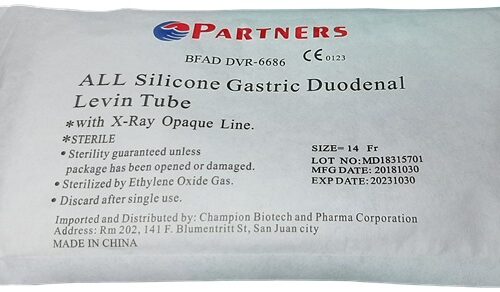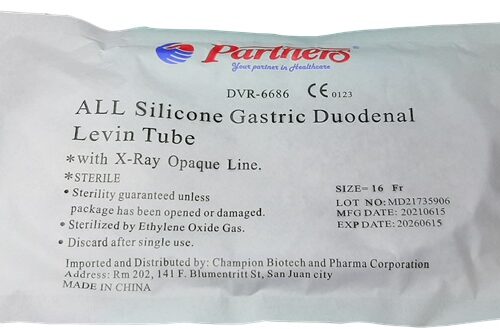Showing 225–240 of 444 results
-
Nasal Oxygen Cannula Adult
0₱21.00> Partners
> Nasal Oxygen Cannula
> Non-toxic
> Non-pyronenic
> Size Adult
> 1 packCaution:
* Federal law restricts this device to sale by or on the order of a physician.
* For single use only.
* Not intended for reprocessing
* Avoid freezing and excessive heatWarning:
* Be sure all connections are secure
Instruction for use:
* attach cannula to the patients face by inserting tips into the nostrils
* Pass cannula tubing over both ears and position under the chin
* Slide adapter up the tubing to adjust for comfort and fit. Tighten only enough to secure cannula in nosetrils
* Attach the order and of oxygen tubing to the oxygen outlet. Adjust flow as directed by physician -
Nasal Oxygen Cannula Neonate
0₱63.00> Surgitech
> Nasal Oxygen Cannula
> Non-toxic
> Non-pyronenic
> Size Neonate
> 1 packCaution:
* Federal law restricts this device to sale by or on the order of a physician.
* For single use only.
* Not intended for reprocessing
* Avoid freezing and excessive heatWarning:
* Be sure all connections are secure
Instruction for use:
* attach cannula to the patients face by inserting tips into the nostrils
* Pass cannula tubing over both ears and position under the chin
* Slide adapter up the tubing to adjust for comfort and fit. Tighten only enough to secure cannula in nosetrils
* Attach the order and of oxygen tubing to the oxygen outlet. Adjust flow as directed by physician -
Nasal Oxygen Cannula Neonate
0₱63.00> Partners
> Nasal Oxygen Cannula
> Non-toxic
> Non-pyronenic
> Size Neonate
> 1 packCaution:
* Federal law restricts this device to sale by or on the order of a physician.
* For single use only.
* Not intended for reprocessing
* Avoid freezing and excessive heatWarning:
* Be sure all connections are secure
Instruction for use:
* attach cannula to the patients face by inserting tips into the nostrils
* Pass cannula tubing over both ears and position under the chin
* Slide adapter up the tubing to adjust for comfort and fit. Tighten only enough to secure cannula in nosetrils
* Attach the order and of oxygen tubing to the oxygen outlet. Adjust flow as directed by physician -
Nasal Oxygen Cannula Adult
0₱32.00> Surgitech
> Nasal Oxygen Cannula
> Non-toxic
> Non-pyronenic
> Size Adult
> 1 packCaution:
* Federal law restricts this device to sale by or on the order of a physician.
* For single use only.
* Not intended for reprocessing
* Avoid freezing and excessive heatWarning:
* Be sure all connections are secure
Instruction for use:
* attach cannula to the patients face by inserting tips into the nostrils
* Pass cannula tubing over both ears and position under the chin
* Slide adapter up the tubing to adjust for comfort and fit. Tighten only enough to secure cannula in nosetrils
* Attach the order and of oxygen tubing to the oxygen outlet. Adjust flow as directed by physician -
Nasal Oxygen Cannula Adult
0₱32.00> Partners
> Nasal Oxygen Cannula
> Non-toxic
> Non-pyronenic
> Size Adult
> 1 packCaution:
* Federal law restricts this device to sale by or on the order of a physician.
* For single use only.
* Not intended for reprocessing
* Avoid freezing and excessive heatWarning:
* Be sure all connections are secure
Instruction for use:
* attach cannula to the patients face by inserting tips into the nostrils
* Pass cannula tubing over both ears and position under the chin
* Slide adapter up the tubing to adjust for comfort and fit. Tighten only enough to secure cannula in nosetrils
* Attach the order and of oxygen tubing to the oxygen outlet. Adjust flow as directed by physician -
Nasal Oxygen Cannula Pedia
0₱32.00> Surgitech
> Nasal Oxygen Cannula
> Non-toxic
> Non-pyronenic
> Size Adult
> 1 packCaution:
* Federal law restricts this device to sale by or on the order of a physician.
* For single use only.
* Not intended for reprocessing
* Avoid freezing and excessive heatWarning:
* Be sure all connections are secure
Instruction for use:
* attach cannula to the patients face by inserting tips into the nostrils
* Pass cannula tubing over both ears and position under the chin
* Slide adapter up the tubing to adjust for comfort and fit. Tighten only enough to secure cannula in nosetrils
* Attach the order and of oxygen tubing to the oxygen outlet. Adjust flow as directed by physician -
Nasal Oxygen Cannula Pedia
0₱32.00> Partners
> Nasal Oxygen Cannula
> Non-toxic
> Non-pyronenic
> Size Adult
> 1 packCaution:
* Federal law restricts this device to sale by or on the order of a physician.
* For single use only.
* Not intended for reprocessing
* Avoid freezing and excessive heatWarning:
* Be sure all connections are secure
Instruction for use:
* attach cannula to the patients face by inserting tips into the nostrils
* Pass cannula tubing over both ears and position under the chin
* Slide adapter up the tubing to adjust for comfort and fit. Tighten only enough to secure cannula in nosetrils
* Attach the order and of oxygen tubing to the oxygen outlet. Adjust flow as directed by physician -
Nebulizer Mask Adult
0₱60.00> Partners
> Nasal Oxygen Cannula
> Non-toxic
> Non-pyronenic
> Size Adult
> 1 packCaution:
* Federal law restricts this device to sale by or on the order of a physician.
* For single use only.
* Not intended for reprocessing
* Avoid freezing and excessive heatWarning:
* Be sure all connections are secure
Instruction for use:
* attach cannula to the patients face by inserting tips into the nostrils
* Pass cannula tubing over both ears and position under the chin
* Slide adapter up the tubing to adjust for comfort and fit. Tighten only enough to secure cannula in nosetrils
* Attach the order and of oxygen tubing to the oxygen outlet. Adjust flow as directed by physician -
Nebulizer Mask Pedia
0₱60.00> Partners
> Nebulizer Mask
>Pedia
> With nebulizer kit
> Non-toxic
> Non-pyrogenic
> Sterile
> Single use onlyIn medicine, a nebulizer (American English) or nebuliser (British English) is a drug delivery device used to administer medication in the form of a mist inhaled into the lungs. Nebulizers are commonly used for the treatment of asthma, cystic fibrosis, COPD and other respiratory diseases or disorders. They use oxygen, compressed air or ultrasonic power to break up solutions and suspensions into small aerosol droplets that are inhaled from the mouthpiece of the device. An aerosol is a mixture of gas and solid or liquid particles.
-
Nebulizer Mask Adult
0₱56.00> Sure-Guard
> Nebulizer Mask
> Adult
> Large
> With nebulizer kit
> Non-toxic
> Non-pyrogenic
> Sterile
> Single use onlyIn medicine, a nebulizer (American English) or nebuliser (British English) is a drug delivery device used to administer medication in the form of a mist inhaled into the lungs. Nebulizers are commonly used for the treatment of asthma, cystic fibrosis, COPD and other respiratory diseases or disorders. They use oxygen, compressed air or ultrasonic power to break up solutions and suspensions into small aerosol droplets that are inhaled from the mouthpiece of the device. An aerosol is a mixture of gas and solid or liquid particles.
-
Nebulizer Mask Pedia
0₱56.00> Sure-Guard
> Nebulizer Mask
>Pedia
> With nebulizer kit
> Non-toxic
> Non-pyrogenic
> Sterile
> Single use onlyIn medicine, a nebulizer (American English) or nebuliser (British English) is a drug delivery device used to administer medication in the form of a mist inhaled into the lungs. Nebulizers are commonly used for the treatment of asthma, cystic fibrosis, COPD and other respiratory diseases or disorders. They use oxygen, compressed air or ultrasonic power to break up solutions and suspensions into small aerosol droplets that are inhaled from the mouthpiece of the device. An aerosol is a mixture of gas and solid or liquid particles.
-
NGT Silicone Gastric Duodenal Levin Tube With X-Ray Fr. 14
0₱237.00> Partners
> NGT silicone Gastric
> Duodenal levin tube
> Fr14
> With x-ray
> Single-use
> Sterile
> Opaque line
> Sterility guaranteed
> Discard after useA nasogastric tube or an NG tube is a long, thin tube made of polyurethane, silicone, or rubber.
It is inserted into a patient?s nasal or oral passage to administer or remove substances in the stomach. Comatose
patients and patients with trauma to their oral pathway also use nasogastric tubes.
How long can you keep a nasogastric tube -
NGT Silicone Gastric Duodenal Levin Tube With X-Ray Fr.16
0₱237.00> Partners
> NGT silicone Gastric
> Duodenal levin tube
> Fr16
> With x-ray
> Single-use
> Sterile
> Opaque line
> Sterility guaranteed
> Discard after useA nasogastric tube or an NG tube is a long, thin tube made of polyurethane, silicone, or rubber.
It is inserted into a patient?s nasal or oral passage to administer or remove substances in the stomach. Comatose
patients and patients with trauma to their oral pathway also use nasogastric tubes.
How long can you keep a nasogastric tube -
NGT Silicone Gastric Duodenal Levin Tube With X-Ray Fr.18
0₱237.00> Partners
> NGT silicone Gastric
> Duodenal levin tube
>Fr18
> With x-ray
> Single-use
> Sterile
> Opaque line
> Sterility guaranteed
> Discard after useA nasogastric tube or an NG tube is a long, thin tube made of polyurethane, silicone, or rubber.
It is inserted into a patient?s nasal or oral passage to administer or remove substances in the stomach. Comatose
patients and patients with trauma to their oral pathway also use nasogastric tubes.
How long can you keep a nasogastric tube -
NGT Stomach Tube Fr. 10 with Cover, 1Pc
0₱16.00> Partners
> Stomach tube
> Fr 10
> Sterile
> Non-toxic
> Single-use
> Lot no; MD20592301
> Exp date: 20250320
> Do not re sterilize or reuse
> Sterile non-pyrogenicCaution:
This is for single-use only, do not re sterilize or reuse.
Sterile Non-pyrogenic. do not store at extreme temperature or in high humidity
Keep away from getting wet
do not use if package is open or damage


